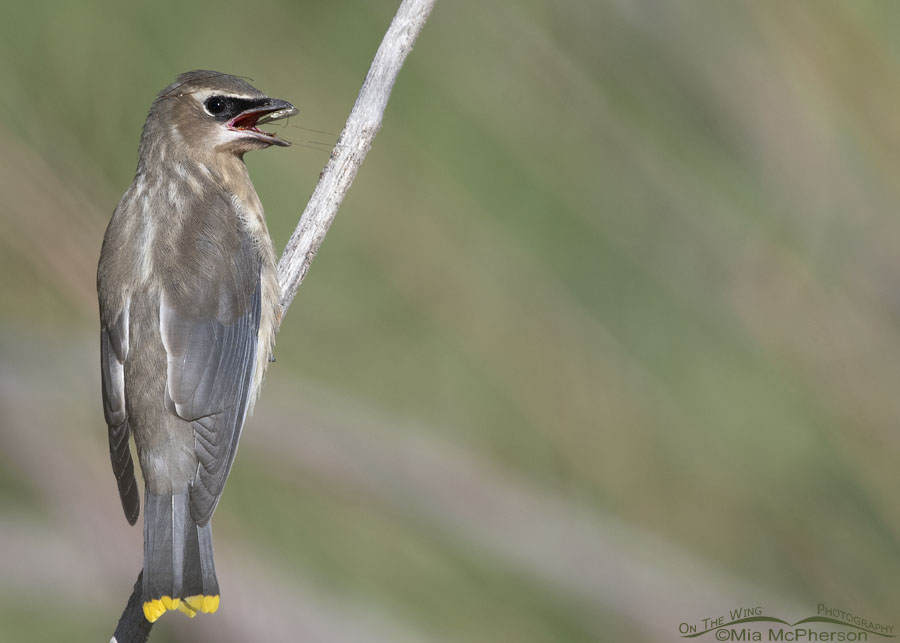 Young Cedar Waxwing eating a crane fly – Nikon D500, f7.1, 1/1600, ISO 500, Nikkor 500mm VR with 1.4x TC, natural light
Young Cedar Waxwing eating a crane fly – Nikon D500, f7.1, 1/1600, ISO 500, Nikkor 500mm VR with 1.4x TC, natural light
It has been about two years since I have had an opportunity to take high quality photos young Cedar Waxwings. In part that is because they blend into their habitat so easily which can make them hard to spot and because they move so fast even when they are young.
I was excited when I found this young Cedar Waxwing out in the open and within the range of my lens right after it caught a crane fly to eat for breakfast high in the Wasatch Mountains.
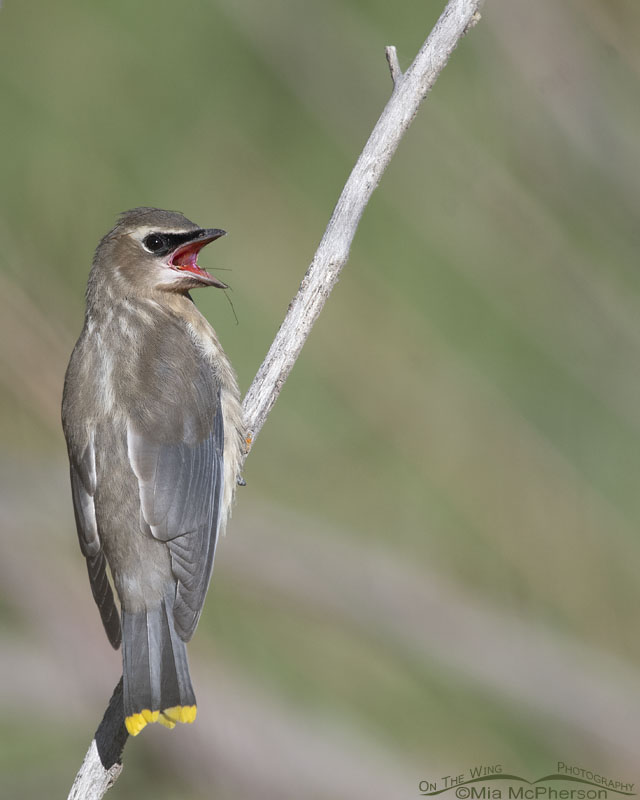 Juvenile Cedar Waxwing with its bill open while eating a crane fly – Nikon D500, f7.1, 1/1600, ISO 500, Nikkor 500mm VR with 1.4x TC, natural light
Juvenile Cedar Waxwing with its bill open while eating a crane fly – Nikon D500, f7.1, 1/1600, ISO 500, Nikkor 500mm VR with 1.4x TC, natural light
Crane flies, which are also known as mosquito hawks or skeeter hawks, look like giant mosquitoes. Crane flies rarely eat anything in their adult forms and when they do it is usually nectar. Crane flies don’t eat mosquitoes so their nicknames aren’t really correct.
This immature Cedar Waxwing had no problem catching the crane fly on its own or scarfing down the body of the insect.
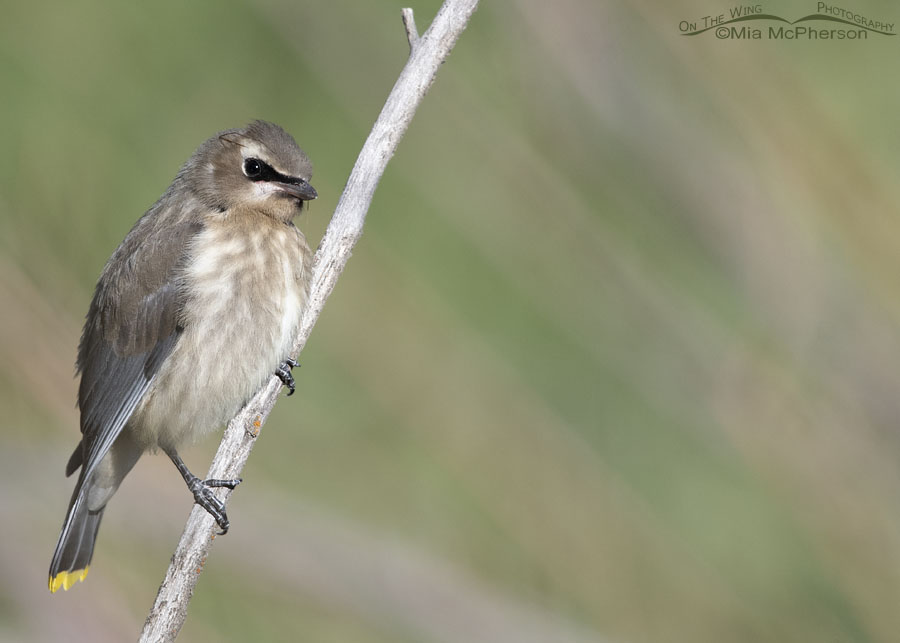 Immature Cedar Waxwing after eating – Nikon D500, f7.1, 1/1600, ISO 500, Nikkor 500mm VR with 1.4x TC, natural light
Immature Cedar Waxwing after eating – Nikon D500, f7.1, 1/1600, ISO 500, Nikkor 500mm VR with 1.4x TC, natural light
I was delighted to take a nice series of images of the juvenile Cedar Waxwing on this perch and figured that it would soon take flight and join the other waxwings that I could see snatching insects from the air above where I sat.
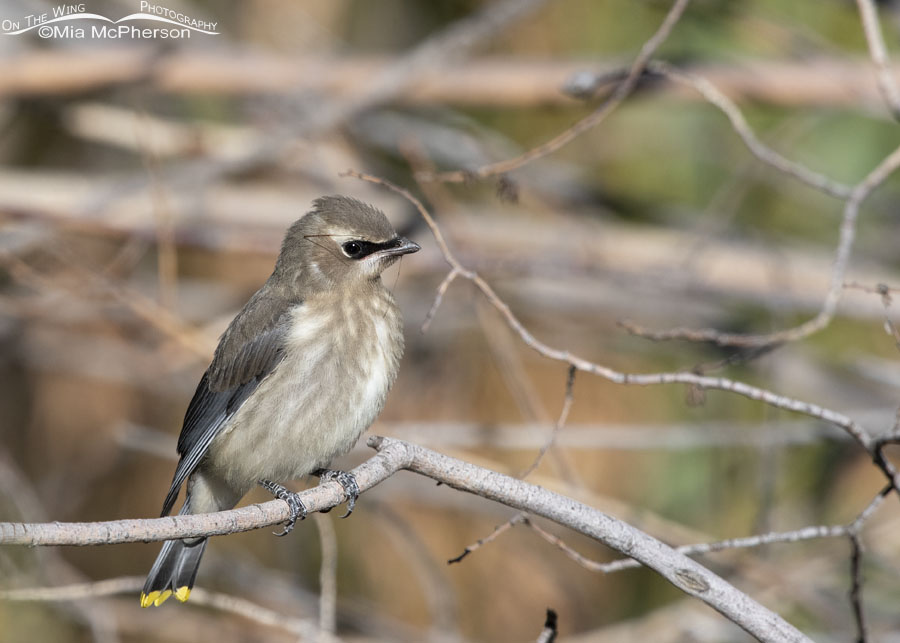 Young Cedar Waxwing with crane fly legs on its head – Nikon D500, f7.1, 1/1600, ISO 500, Nikkor 500mm VR with 1.4x TC, natural light
Young Cedar Waxwing with crane fly legs on its head – Nikon D500, f7.1, 1/1600, ISO 500, Nikkor 500mm VR with 1.4x TC, natural light
But this immature Cedar Waxwing had found a location where there were bugs a plenty so it hung around, chased after prey, caught prey, and perched out in the open often.
You might be able to see some long, dark things attached to the young waxwing’s head behind its eye and in front of its bill that don’t quite look like feathers in this photo.
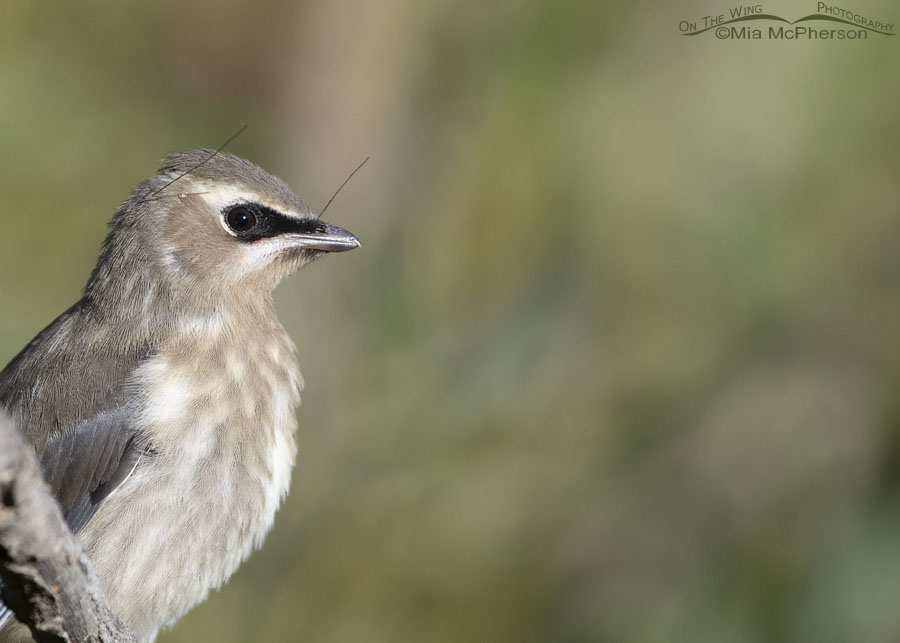 Close up of an immature Cedar Waxwing with crane fly legs on its head – Nikon D500, f7.1, 1/1600, ISO 500, Nikkor 500mm VR with 1.4x TC, natural light
Close up of an immature Cedar Waxwing with crane fly legs on its head – Nikon D500, f7.1, 1/1600, ISO 500, Nikkor 500mm VR with 1.4x TC, natural light
Those dark things aren’t feathers at all, they are the legs of the crane fly the young waxwing had eaten earlier. Those legs look more than a little odd sticking out at crazy angles from the head of this bird but for a bit the legs made it easier for me to tell it was the same young waxwing as it foraged, took flight, landed and gobbled down other prey.
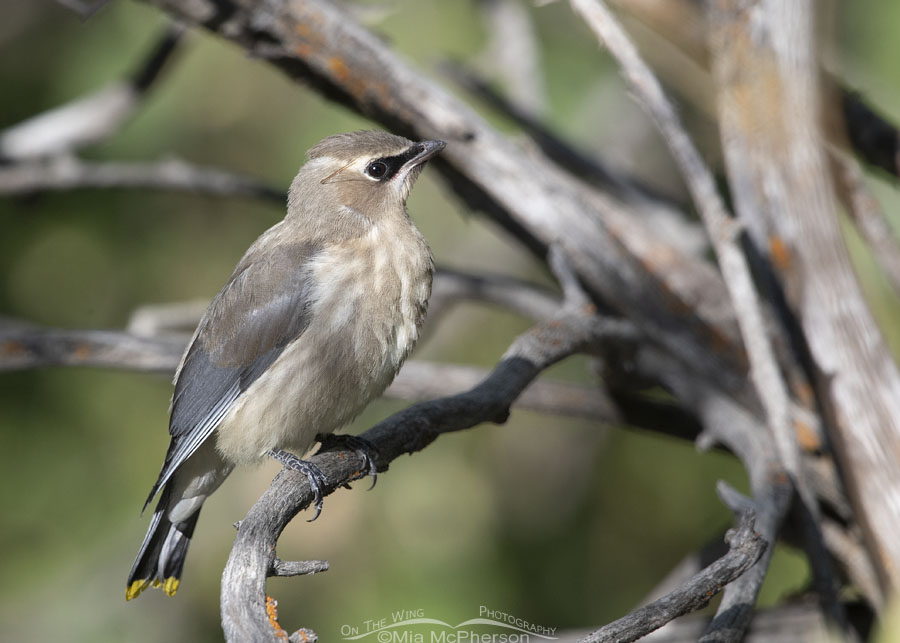 Resting immature Cedar Waxwing – Nikon D500, f7.1, 1/800, ISO 500, Nikkor 500mm VR with 1.4x TC, natural light
Resting immature Cedar Waxwing – Nikon D500, f7.1, 1/800, ISO 500, Nikkor 500mm VR with 1.4x TC, natural light
The juvenile Cedar Waxwing spent much of the time out in the open which allowed me to take photos of it in several different settings.
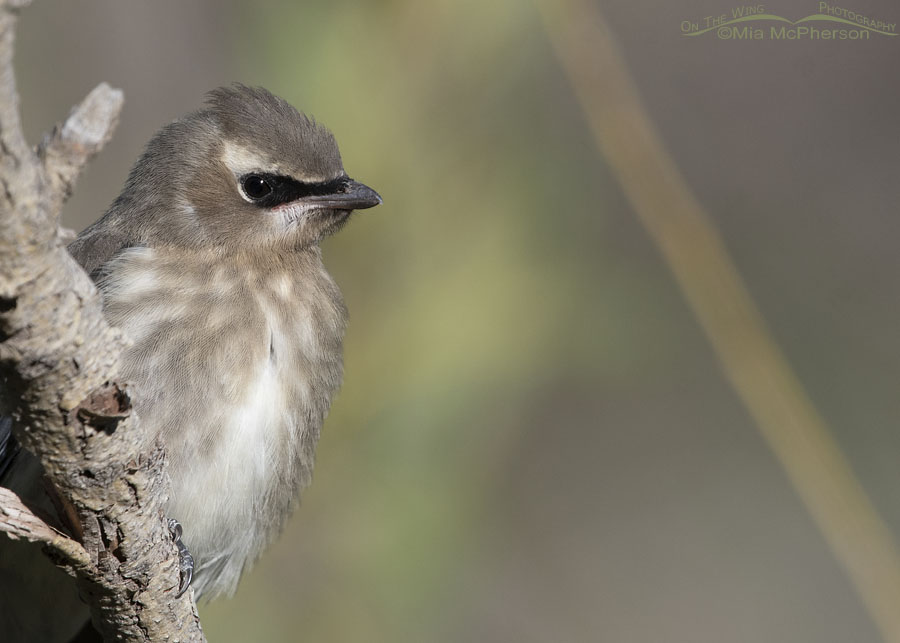 Immature Cedar Waxwing portrait – Nikon D500, f7.1, 1/2000, ISO 500, Nikkor 500mm VR with 1.4x TC, natural light
Immature Cedar Waxwing portrait – Nikon D500, f7.1, 1/2000, ISO 500, Nikkor 500mm VR with 1.4x TC, natural light
A few times the young Cedar Waxwing flew in close enough that I was able to take portraits of it. I have always enjoyed talking close up photos of my feathered subjects because of the fine details these photos can show.
Notice that the crane fly legs are missing in this frame? They must have finally been knocked off when this young waxwing preened for a bit behind some leaves high up in a willow. I took a few photos of that action but there were just too many obstructions in front of the bird so those image files will go into my delete bin.
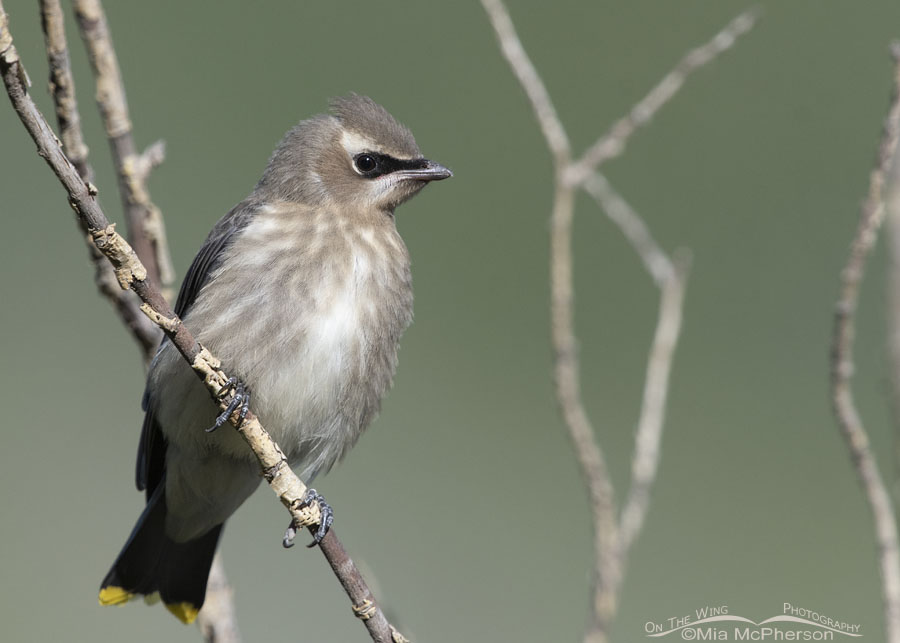 Perched immature Cedar Waxwing – Nikon D500, f7.1, 1/1600, ISO 500, Nikkor 500mm VR with 1.4x TC, natural light
Perched immature Cedar Waxwing – Nikon D500, f7.1, 1/1600, ISO 500, Nikkor 500mm VR with 1.4x TC, natural light
This young Cedar Waxwing kept me busy photographing and watching it move around as it captured prey. I spent a little more than twenty minutes with this young Cedar Waxwing in my viewfinder and I know that it was time well and joyfully spent.
Life is good. Stay safe.
Mia
Click here to see more of my Cedar Waxwing photos plus facts and information about this species.


What a terrific series of pics of an immature Cedar Waxwing, crane fly legs and all. I was mildly surprised that the markings were so distinct in a bird so young. Thanks Mia.
What a sweet face! With and without the extra legs.
I am so very glad that this cutie managed to rid itself of those pesky legs. And that you spent some joyous time with it.
Gosh, Mia, what a gift this young bird gave to you, and through you, to us!
Incredible photos! Wonderful detail!
Thank you, as always, for sharing the beauty of your world
and your photographic talent!
Mary
Theses are great-legs and all.
These are wonderful! I hope the 4 orphaned rehab raised I released in the area are doing as well.
Gorgeous shots. What a cutie!
Wonderful series of immature shots!